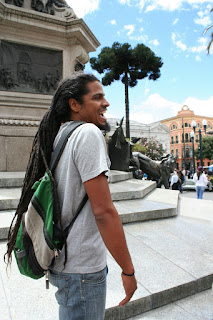There is a particular dawn chorus in the San Juan district of Quito. Long before the alarm goes off, we are serenaded by dogs howling and barking (I am sure because they are cooped up in their homes and gardens rather than free to roam the streets), people yelling, and vehicles driving back and forth, tooting their horns repetitively and incessantly (presumably alerting us to the wares they have for sale). This had us restless and awake from 5am.
Today the earlier awakening worked in our favour, so that we had plenty of time to eat, dress, and get ourselves down to the Community Hostel, which runs a daily walking tour of
el centro histórico.
 |
| Walking to the historic centre |
 |
| Looking over the city |
Our guide, Ovi, sporting dreads that earn him the nickname "Bob Marley" on the streets of Quito, took us first to the nearby Mercado Central.
 |
| No worries |
We had visited this the previous day on our self-guided tour, and found a much different experience to the markets of Bolivia. Inside a two-storey building, well-maintained market stalls sell flowers - a bunch of five roses will set you back only one dollar - neat piles of fruit and vegetables, and, by far the majority, cooked food, such as
caldo de pata, made with cow's hooves.
 |
| Hooves for sale |
Since little is vegetarian-friendly in the market - including the famous "Don Jimmy" deep-fried
corvina (sea bass) - we tried freshly blended juices of
guanábana and blackberry (
mora) with coconut milk.
 |
| Juice lady |
From the market, we processed through the plazas of the old town learning of its history. Plaza de la Independencía (also Plaza Grande) celebrates the struggle of the country that was the leading light in the fight for independence from Spain - hence Quito's nickname,
Luz de América. The people called for independence as early as 1809, finally achieving it in May of 1822.
 |
| Liberty statue on Plaza Grande |
Quito was also the centre of the 'discovery' of the Amazon river, as the Spanish expedition left from here in 1541 to discover cinnamon and gold - in search of the fabled city '
El Dorado' - but found only the largest Río Amazonas. The group reached the river after 12 months' gruesome travel involving suffering, starvation, and attack from the increasingly belligerent natives, whose villages were sacked and burned by the travelling conquistadors.
 |
| Government Palace |
These tales and more were recounted under much more favourable conditions than we had arrived to. The temperature felt less chilly as the grey cloud dissipated, allowing the colour of the city's buildings to enliven the streets.
 |
| Colourful Quito |
The streets are full of small artisanal shops and, on one particular road, the vendors specialise in the thing that unites the South American palate: sugar. The confectioners here sell sweets made from sesame seeds, peanuts, and coconut, all bound together with
panela (unrefined sugar), as well as chewy
membrilla (quince jelly), crumbly dulce de leche fudge, as well as the disconcertingly green and tooth-achingly sweet
higo confitado (balls of candied fig pieces).
 |
| Dulces |
We bought some of the sugary snacks, paying with US dollars which is the first time since Cambodia that we have used the familiar-yet-foreign currency. However, whereas in Cambodia the dollar shared place with the other 'official currency', the riel, Ecuador jettisoned its own lucre - named after the liberatador Mariscal Sucre - in 2000, in favour of the greenback. This followed a period of hyperinflation that saw the exchange rate rocket from 15 sucres to the dollar in 1950 up to 25,000 sucres before it was withdrawn from circulation.
 |
| Plaza San Francisco |
 |
| Inside the cathedral |
Our guide ended by inviting us to lunch at a typical
almuerzo place that he frequents, but we declined knowing that there would be little in the way of vegetarian catering. Instead, we took lunch in a place equally popular with the local crowd, Ari '
comida sana'. The 'healthy food' (for $2.50) turned out to be a menu of lentil and yuca soup, followed by
tallerin - long pasta, contrast
fideo (short pasta) - with vegetables and fake meat. A small banana fritter at the side had the taste and appearance of dessert that had inadvertently crept onto the plate, but the true dessert was a chocolate drink and a slice of spiced apple.
 |
| Comida sana |
The winged Virgin of Quito tops
El Panecillo - a round hill that resembles a small bread bun after which it takes its name - and can be seen from much of the city, especially along the avenue Venezuela, which runs from its base, through the historic centre, to the
Basilica del Voto Nacional.
 |
| View to the south - El Panecillo |
 |
| View to the north - La Basilica |
We climbed the steps of the basilica's towers, the last few metres of which require climbing near-vertical metal rungs, for a spectacular view of Quito and of the Panecillo through its towers.
 |
| View from the top of the basilica |
Unusually, the decoration of the church exterior eschews the typical gargoyles in favour of aardvarks, monkeys, crocodiles, and pumas.
 |
| Well, why not? |
At home, I got to grips with the limited kitchen facilities to turn out a small dinner of tofu and vegetables on rice. I shared commiserations with the other guest who turned up while I was cooking to prepare his own meal - predictably pasta and tomato sauce - as I had monopolised both pans. He passed favourable comments on our food, but had a long wait for his own, as the rice (brown ) takes an age to cook at this altitude.
 |
| Long-awaited sustenance |


















No comments:
Post a Comment